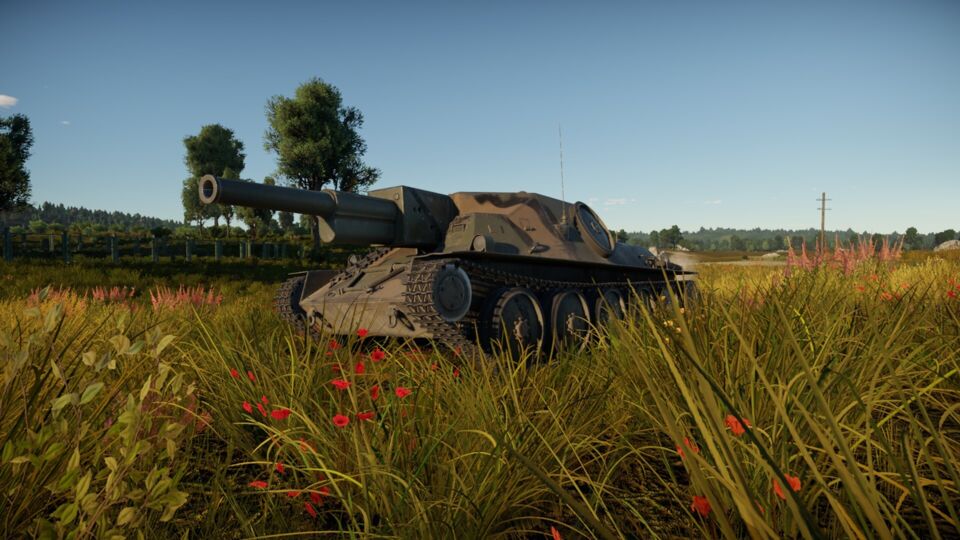#sweden
The Swedish AJ37 Viggen is a strike aircraft boasting a deadly armament of missiles and guns, combined with an extremely powerful engine. In the hands of a good pilot, it can cause chaos on the ground forces below. It is a huge upgrade from the previous strike aircraft in the Swedish tech tree, the A32A Lansen, with much better capabilities including its weaponry, radar, RWR, and more.
The Ikv 91 is a light infantry fighting and support vehicle developed by Hägglunds. This tank was designed to fill a similar role as the Russian PT-76 tanks. The first prototypes of this vehicle were delivered in 1969 and underwent in-depth testing by the armed forces. The first prototypes did not feature an automatic transmission and also were only equipped with an optical rangefinder, which required the commander’s cupola to be notably bigger. In 1972, the Swedish army ordered 200 Ikv 91 tanks, with another 12 being ordered in 1975. After several modernization attempts, this vehicle was ultimately retired in 2002.
The Lago series refers to Landsverk’s production designation of the Stridsvagn m/42, which served as Sweden’s standard medium tank during the end of World War II, which began as an export product and ended up in the use of the Swedish Army where it would serve for decades to come. This article provides an overview of the vehicle’s history and fate.
The CV 90105 TML was a conceptualized light tank that resulted from a cooperation between Hägglunds and GIAT on the basis of the CV 90 platform while using various already existing components. The vehicle was showcased at Eurosatory in 1994 and was meant to show the multirole usage and capabilities of the CV 90 chassis. The vehicle underwent in-depth testing, but ultimately no country ever showed interest in the tank, and the project was abandoned.
The SAAB 29, commonly known as the "Flygande Tunnan" or "Flying Barrel", was Sweden's first mass-produced jet fighter. Developed in the aftermath of World War II as Europe's first swept-wing jet fighter, its remarkable performance, adaptability, and family of variants extended its operational life from the early 1950s into the late 1970s, and propelled Sweden to the forefront of jet fighter development in the years to come.
The SAV 20.12.48 is a Swedish tank destroyer at rank III, featuring a 120mm automatic cannon. This large-caliber cannon has an incredible reload speed of only 1.2 seconds, making this tank very unique. Not only does this cannon reload quickly, but the APCBC round holds 890g of explosive filler, (for reference the Jagdtiger’s best APCBC round holds 786g), making this APCBC act almost like a HE. The amazing firepower isn’t the only thing the SAV boasts though, it also features great maneuverability, and when paired with its firepower, this tank becomes the ultimate flanker.
The JA37C “Viggen” is a Swedish indigenous fighter developed from the successful AJ37, first seeing operational service in 1980. Designed to replace the J35 Draken as Sweden’s primary air defense fighter, the Viggen was capable of many unique things, such as being able to operate from extremely short runways with its short takeoff run and thrust reversers for landing. A unique canard design, the Viggen served the Swedish Air Force well, being retired in 2007 after handing over its job to the JAS 39 Gripen.
The Stridsvagn 103 (Strv 103), also referred to as the S-tank or Stridsvagn S, was a Swedish MBT manufactured by Bofors AB. It was in service during the Cold War, at a time where tank technology was rapidly advancing. The tank is instantly recognizable by its flat, turretless profile, and is frequently referred to as a cheese wedge or doorstop.
The LT vz.38 was a light tank originally from Czechoslovakia and built by Škoda and ČKD. A total of at least 6,919 examples were built, including pre-war and licensed models in every imaginable configuration. Following the German occupation of Czechoslovakia in 1939, the German Reich captured plans, production equipment, and some examples of the LT vz.38 that had not yet been deployed in the Czech army and renamed them the Pz. 38(t). Later, a licensed version, along with some examples, was sold to Sweden, who renamed it the Stridsvagn m/41 and slightly modified it. The Pz. 38(t) was used by Germany throughout World War II and also influenced several other tank designs, including the German E-series.









